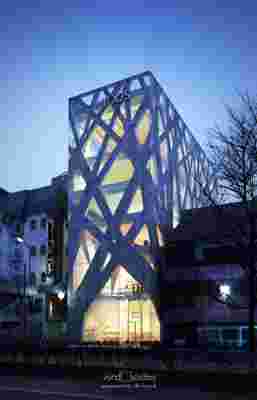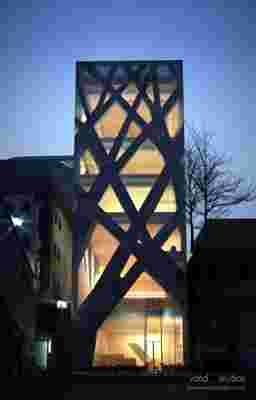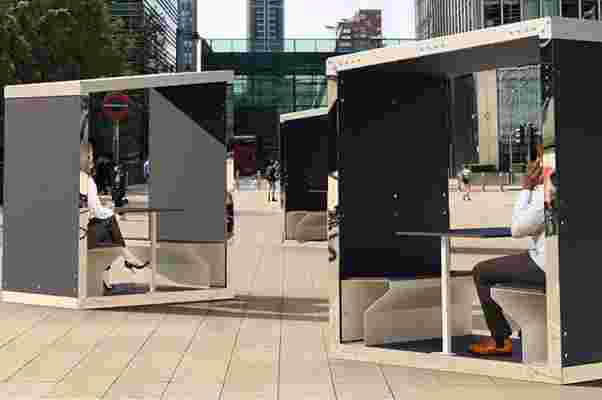
In recent months, cafes and outdoor workspaces have limited their public amenities to avoid crowding. No more WiFi, the bathrooms are always locked, and time limits for tables are used to control foot traffic. Even still, with pandemic mandates resurfacing, the first taste of bringing our laptops to our favorite cafe to get our work done is hard to kick. Offering their own solution to the unpredictable circumstances of today’s world, furniture studio Duffy London debuted the Minka Solar Pod, an outdoor companion to their indoor office pod.
The Minka Solar Pod operates primarily as an alternative to meeting places and WFH spots like WeWork and cafes with WiFi. Unlike their indoor counterpart, the Minka Solar Pod and its amenities are entirely powered by photovoltaic panels and lithium-ion batteries. Using solar energy for power allows Minka Solar Pods to be placed anywhere, from busy city plazas like Union Square or public grounds like Hyde Park. Designed to be an outdoor working space, Minka Solar Pods come complete with four USB ports for charging and acoustic panels to quiet outdoor noise while amplifying the conversations taking place inside the pod.
Each Minka Solar Pod also accommodates up to four people, which means work meetings that would typically remain indoors could be taken outdoors for some fresh air and a change of scenery. Minka Solar Pods were also built to be weather-resistant, with high-grade walnut and oak veneers finished with powder-coated mild steel. So come drizzle or shine, there’s always an excuse to bring work outdoors. Describing his own inspiration behind the Minka Solar Pod and its indoor companion, Duffy London founder, and director, Chris Duffy says,
“We wanted to design a piece of communal furniture that can meet the needs of the modern working and municipal environment. Indoor or outdoor, our Minka PODs serve as highly adaptable, non-defined spaces that act like mini-hives for human interactions.”
Designer: Duffy London
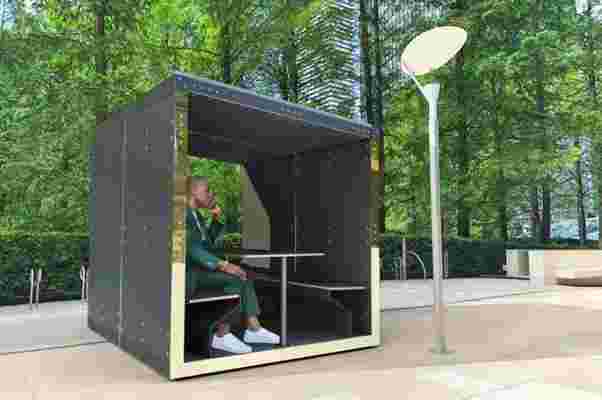
Clad with powder-coated mild steel, Minka Solar Pods are built to brace the weather.
Minka Solar Pods were initially designed to provide an outdoor workspace for small business meetings or a change of scenery for those of us still working from home.
Outside of work, Minka Solar Pods can function as social meeting hubs for friends and coworkers alike.
Developed in varying structures, Minka Solar Pods embrace the same open-air, collaborative environment.
Each Minka Solar Pod comes equipped with four USB ports and photovoltaic panels to stay powered and charge your devices.
With acoustic panels, Minka Solar Pods quiet the outside noise while amplifying the conversations taking place inside of the pod.
The pod’s high-grade walnut and oak veneers were derived from sustainably sourced forests under the supervision of the Forest Stewardship Council.
If Greta Thunberg was a building, she would be this one!
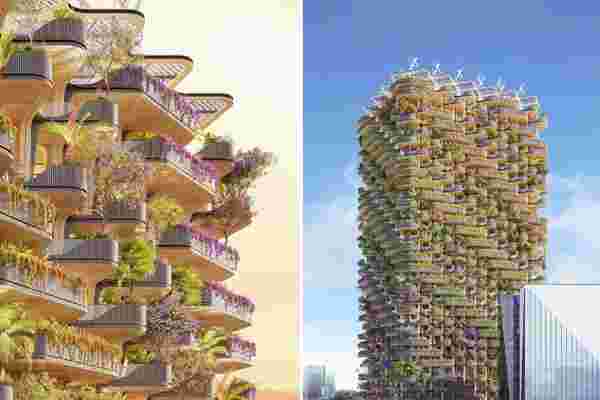
Every day we are seeing innovative architecture that is blending tech with nature to fit our modern lifestyles while benefitting the environment. These hybrid structures that think about humans and nature alike often result in the most beautiful buildings. The latest addition in sustainable architecture is the Rainbow Tree in Cebu, Philippines by Paris-based Vincent Callebaut Architectures which reduces the carbon footprint of every future resident.
The design team has described the Rainbow Tree as a multi-faceted revealing structure that pays tribute to the cultural and natural Filipino heritage. Cebu is one of the 66 creative cities awarded by UNESCO for its innovation in design, fashion, architecture, and the production of eco-responsible furniture – an example of the new world we are trying to build. The aim was to design a residential apartment that blended the luxury lifestyle with a sustainable lifestyle while being LEED + BERDE certified (environmental certifications). The 32-story tower stands at 115-meter and will be built using solid wood which is a natural renewable material available in abundance locally while 30,000 plants will grace its exterior. The technique is a genius one – the wooden slats are perpendicularly superimposed and connected using structural, organic adhesives such as tannins, lignin, cellulose, or even starch. “This organic building integrates the principles of passive bioclimatism and advanced renewable energies. We named it ‘The Rainbow Tree’ because it is an ode to Eucalyptus Deglupta, also known as Rainbow Eucalyptus, an iconic and colorful tree from the Philippines,” says the team.
You must be thinking about the wood being a fire hazard but the Eucalyptus is a slow-burning wood that does not release toxic fumes and transmits heat 250 times slower than melting steel and 10 times slower than concrete which cracks under the effects of the flames. There are 1,200 geometric modules stacked to make the structure and each module’s side measures 4 meters with the height varying between 3.2 to 4.8 meters. All the timber modules are prefabricated and standardized in a factory for precise mass production. The Cross Laminated Timber manufacturing process requires much less energy than concrete or steel, and moreover it does not generate greenhouse gases. Fun fact: the construction industry is a larger contributor to global warming than the airline industry, particularly the production of concrete. The local plants in the interconnected terraces create a natural ventilation system and are the glue for a symbiotic relationship between the residents and nature.
The trees are cut and harvested in short circuits from eco-responsible forests where each tree cut is replaced by planting another in the archipelago. As the trees grow they store carbon which would be released if not used to build the Rainbow Tree into the atmosphere – for 1 ton of wood produced, about 0.9 tonnes of carbon is confined which means the building has a negative carbon footprint! If Greta Thunberg was an architectural marvel, she would definitely be the Rainbow Tree.
Designer: Vincent Callebaut Architectures
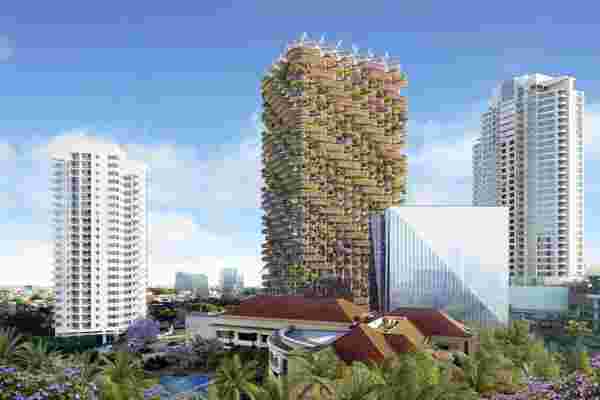
Live in Tokyo? Want To Buy Some Italian Shoes?
Then you should head over to Tod’s, an Italian footwear retailer, on Tokyo’s Ometesando boulevard. At the very least, act like you’re shopping while taking in the grandeur of its ornate facade that branches out like a concrete tree, covering and supporting its six floors of overpriced loafers. In creating the shop, the architects had but 33 feet of street frontage to grab shoppers’ attentions with, opting to partially conceal and entice the public with a kind of concrete lingerie.
Designers: Toyo Ito & Associates
Architectural renderings courtesy of Vond Studios
